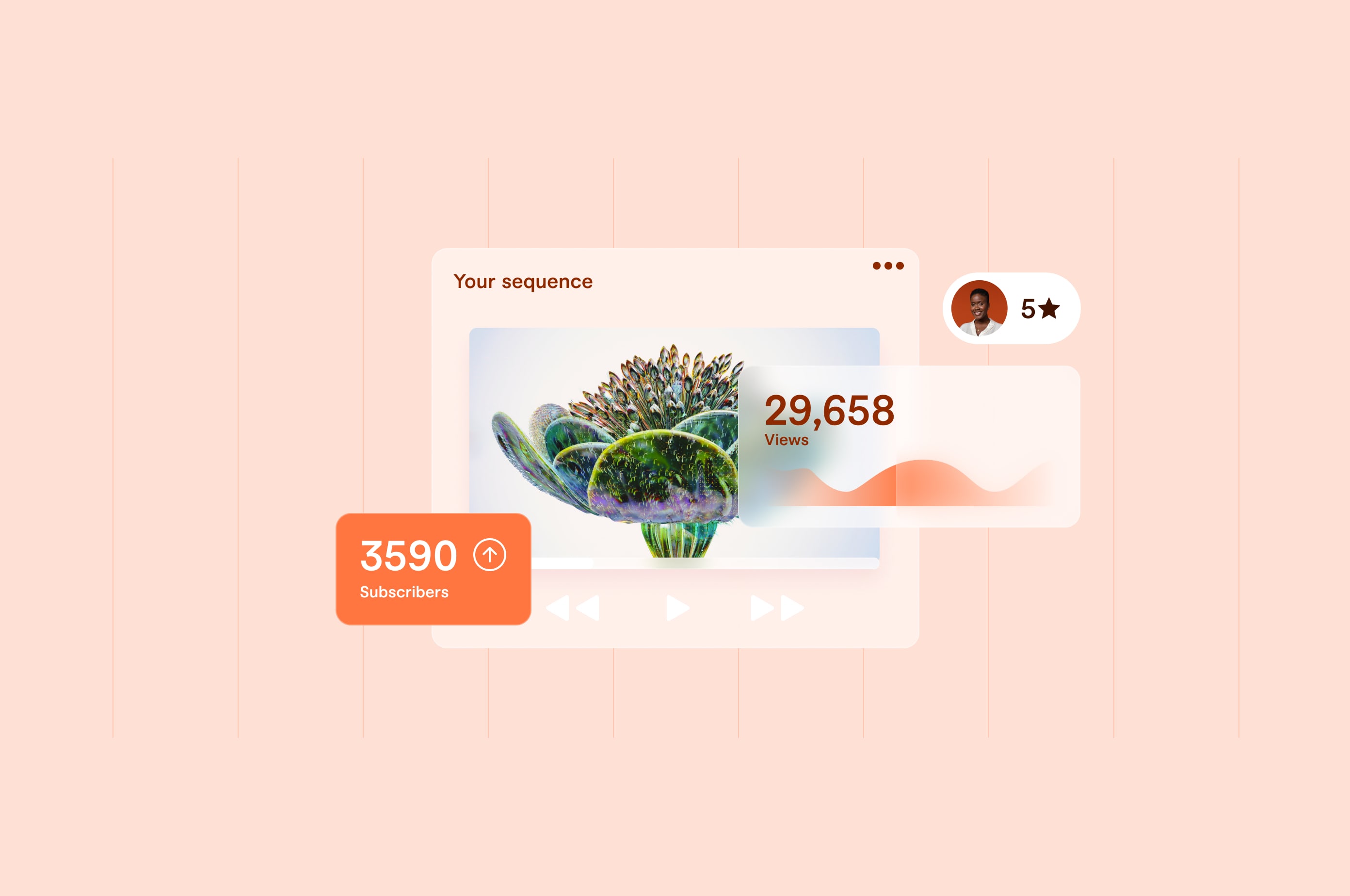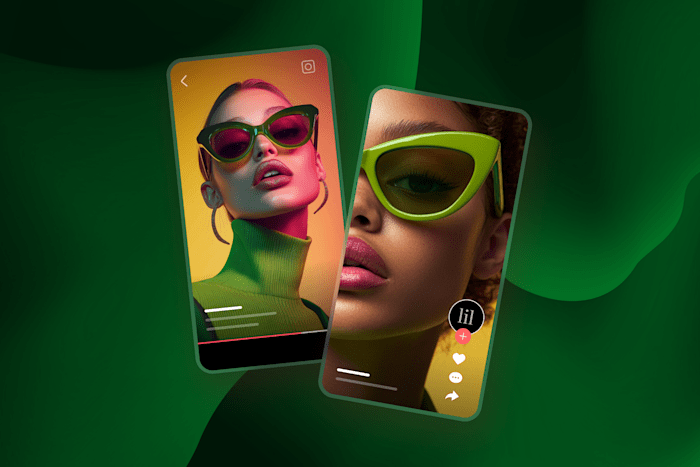Which social media platform is right for your video campaigns in 2025?
Explore the best platforms for social video in 2025, and how to pick the right one for your goals.
 April 2, 2025
April 2, 2025 12 minute reading
12 minute reading
A huge part of using social media for business growth is creating video content—89% of businesses use video as a content marketing tool in 2025.
But not every type of video works on every social media video platform. Some platforms are short-form only, some prioritize diverse engagement, and others favor watch-time.
In this guide, we’ll walk you through the most popular platforms where video content is a prominent (or growing) functionality.
Beyond the platform overviews, we’ll also give best practice tips and advice for choosing the best platforms for your business.
The best social media video platforms for sharing content
1. YouTube
YouTube is the most widely used video marketing platform. It's the one that 90% of marketers use for their marketing strategy. And it's for a good reason—users can find virtually any niche of video on the platform.
However, with such a large quantity of content, it can be hard for businesses to stand out on YouTube, and for new creators to become YouTube influencers.
YouTube’s user base and demographics
The total ad reach (AKA accounts that could receive advertisements) is 2.53 billion.
Female users make up 46% of the user base.
Male users make up 54% of the user base.
By age group and gender, the demographics of users are as follows:
18–24 years old = 6.9% female, 8.9% male
25–34 years old = 9.7% female, 12% male
35–44 years old = 6.4% female, 7.6% male
45–54 years old = 6.4% female, 7.6% male
55–64 years old = 4.7% female, 5.2% male
65+ years old = 4.9% female, 4.6% male
Countries with the highest average app sessions per month include:
South Korea = 335.7
India = 251.9
Thailand = 242.7
Japan = 242.4
Russia = 237.9
Of the predominantly English-speaking countries:
USA = 221.7
Australia = 172.3
Canada = 172
UK = 158.4
Ireland = 150.4
New Zealand = 90.9
YouTube’s content focus
YouTube hosts a diverse range of content, but the most popular categories include entertainment, stunt/giveaway content, music, kids' shows, and gaming. Educational channels are also a viable option. In fact, YouTube may be the best place to find general educational content on this list.
YouTube’s discoverability
YouTube’s algorithm is complex, so search optimization is crucial for visibility. The best approach is to create eye-catching titles and thumbnails and use keyword-rich descriptions for search rankings. Hashtags and tags have minimal impact on discoverability.
YouTube’s monetization options
YouTube offers tiered monetization based on channel statistics:
Tier 1 (500+ subs, 3,000 watch hours OR 3M Shorts views): Unlocks memberships, Super Chats, and Shopping.
Tier 2 (1,000+ subs, 4,000 watch hours OR 10M Shorts views): Unlocks ads, YouTube Premium revenue, and Shorts Feed ads.
YouTube’s unique features
Evergreen content: YouTube videos remain discoverable for years via Google search.
Google AdSense integration: Creators can earn directly from ads, unlike platforms that rely on sponsorships.
YouTube’s content policies and moderation
Through AI moderation and human review, YouTube enforces harmful content, misinformation, copyright, and monetization policies. The three-strike system resets every 90 days, leading to demonetization or account bans for repeat violations.
YouTube’s live streaming
Streaming is easy on desktop, but mobile streaming requires 50+ subscribers. Features like Super Chats and memberships allow monetization during live sessions.
YouTube’s best practices for growth
Create engaging, niche-specific content: Hook viewers early and keep them watching.
Optimize for search: Use SEO-friendly titles, thumbnails, and descriptions for long-term visibility.
Prioritize consistency and engagement: Post at least once weekly, encourage comments, likes, and shares, and interact with your audience.
Hire a YouTube expert on Fiverr
2. TikTok
TikTok rose to prominence in 2018, becoming the most downloaded app in the United States that year. It started as a short-form video platform, but now allows up to 60 minutes of video content.
TikTok’s user base and demographics
The total ad reach is 1.59 billion.
Female users make up 44.3% of the user base.
Male users make up 55.7% of the user base.
The demographics of users, by age group and gender, are as follows:
18–24 years old = 14.1% female, 16.6% male
25–34 years old = 14.6% female, 20.7% male
35–44 years old = 7.2% female, 9.2% male
45–54 years old = 4.3% female, 4.9% male
55+ years old = 4.1% female, 4.3% male
Countries with the highest average app sessions per month include:
Finland = 587.7
Austria = 552.3
Croatia = 489.1
Bulgaria = 481.8
Romania = 458.3
Of the predominantly English-speaking countries:
Ireland = 421.6
Canada = 313.5
Australia = 304
UK = 286
USA = 268.9
New Zealand= 240.1
TikTok’s content focus
TikTok thrives on spontaneous, trend-driven content. Most viral videos feature quick, engaging clips, often filmed in the moment or as the creator thinks out loud. The platform heavily favors entertainment, challenges, and storytelling.
TikTok’s discoverability
In theory, TikTok’s algorithm tests videos with a small audience and pushes them to a wider audience if engagement is high. Unlike YouTube, hashtags impact searchability and help surface content for the right audience.
TikTok’s monetization options
To qualify for monetization, creators must be 18+, follow guidelines, and have a TikTok account in good standing. Available monetization options include:
Creator Rewards Program: Pays per 1,000 views (10K+ followers required).
TikTok Shop: Sell ecommerce products, digital products, or services.
Live Streaming: Collect tips and virtual gifts.
Subscriber-Only Videos: Offer exclusive content for paying members.
Affiliate Marketing: Partner with brands via the Creator Marketplace.
TikTok’s unique features
Music Licensing: Universal Music Group deal allows easier use of trending songs.
CapCut Integration: TikTok’s built-in video editing app for seamless content creation.
TikTok’s content policies and moderation
TikTok prohibits hate speech, misinformation, explicit content, and self-harm promotion. AI-generated content must be disclosed and labeled below the video. Automated moderation scans uploads, then humans review the flagged videos.
TikTok’s live streaming
TikTok Live is a popular format, but eligibility requires at least 1,000 followers (requirements vary by region). Some monetization features, like virtual gifts, are exclusive to live streaming.
TikTok’s best practices for growth
Prioritize short-form storytelling. Fast-paced videos with jump cuts and captions perform best.
Optimize for watch time. Hook viewers immediately and keep them engaged until the end.
Post consistently. Daily uploads boost visibility and help TikTok’s algorithm push your content.
Find a TikTok Expert for Hire
3. Instagram
Instagram originally specialized as a photo-sharing app. They developed video later in the form of video posts, then IGTV (which has since been shut down). However, with users spilling over to TikTok, Instagram responded with its short-form video feature, Reels, in 2020. Unlike Instagram Stories, Reels stay on your profile until you manually remove them or deactivate your account.
Instagram’s user base and demographics
The total ad reach is 1.74 billion.
Female users make up 47.3% of the user base.
Male users make up 52.7% of the user base.
By age group and gender, the demographics of users are as follows:
18–24 years old = 14.4% female, 17.2% male
25–34 years old = 14.6% female, 18.4% male
35–44 years old = 8.5% female, 8.8% male
45–54 years old = 5.2% female, 4.4% male
55–64 years old = 3% female, 2.2% male
65+ years old = 1.9% female, 1.4% male
Countries with the highest average app sessions per month include:
Turkey = 581.5
Chile = 554
Argentina = 502.8
Czechia = 477.1
Greece = 431.2
Of the predominantly English-speaking countries:
Ireland = 251.8
New Zealand = 222
Canada = 219.6
Australia = 203.5
USA = 187.1
UK = 160
Instagram’s content focus
Instagram video thrives on a mix of curated aesthetics and trend-driven content. While Reels compete with TikTok’s short-form style, Instagram still favors polished, high-quality visuals for storytelling, education, and product promotion.
Instagram’s discoverability
Instagram prioritizes engagement (watch time, comments, shares, saves) over hashtags. Reels and the Explore page are key for discovery, and suggest content based on user interactions. Unlike YouTube’s search-driven approach, Instagram focuses on a network-based reach with some algorithmic expansion.
Instagram’s monetization options
Reels Bonus Program (invite-only, region-dependent).
Subscriptions for exclusive content.
Instagram Badges (tipping during live streams).
Affiliate marketing (commission on tagged products).
Brand sponsorships and Instagram Shops for product sales.
Instagram’s unique features
Meta integration (cross-post to Facebook).
Shoppable videos for direct purchases.
90-second Reels allow for deeper storytelling.
Instagram’s content policies and moderation
Instagram prohibits hate speech, misinformation, explicit content, and self-harm promotion. AI content is allowed but must be disclosed. Automated moderation scans videos, but enforcement can be inconsistent.
Instagram’s live streaming
Instagram Live offers real-time engagement, brand launches, and eCommerce integration (aka Live Shopping ecommerce videos). Creators can earn tips via Badges and collaborate with guests for higher reach.
Instagram’s best practices for growth
Focus on Reels. Short, fast-paced videos with trending sounds perform best.
Maximize engagement. Prioritize comments, shares, and saves over likes.
Cross-promote content. Share videos on Stories, Facebook, and Threads for wider reach.
Find an Instagram manager for your business today
4. Facebook
Facebook is one of the oldest social media platforms (it has existed since 2004) and is also one of the most versatile for promotional video ideas.
It offers users a variety of content types, such as text, video, and images, as well as multiple ways to engage with others on the platform, like Groups and Pages (where a lot of video sharing happens).
Facebook’s user base and demographics
The total ad reach is 2.28 billion.
Female users make up 43.3% of the user base.
Male users make up 56.7% of the user base.
By age group and gender, the demographics of users are as follows:
18–24 years old = 9.1% female, 12.7% male
25–34 years old = 12.7% female, 18.5% male
35–44 years old = 8.7% female, 11.7% male
45–54 years old = 5.7% female, 6.6% male
55–64 years old = 3.9% female, 4% male
65+ years old = 3.4% female, 3% male
Countries with the highest average app sessions per month include:
Egypt = 535.2
U.A.E = 489
Philippines = 423.3
Saudi Arabia = 344.1
Vietnam = 342.9
Of the predominantly English-speaking countries:
New Zealand = 279.6
Ireland = 259.4
Canada = 241.6
UK = 211.6
USA = 201.8
Australia = 199
Facebook’s content focus
Facebook video offers a mix of short-form Reels, live streams, and longer videos tailored for social sharing. Unlike YouTube’s search-driven content or TikTok’s fast-paced trends, Facebook prioritizes viral, engagement-heavy videos. The most popular content includes news, viral challenges, lifestyle, DIY, and inspirational clips, often designed to spark discussion or reactions.
Facebook’s discoverability
Facebook’s algorithm favors engagement-driven content, pushing videos that get likes, shares, comments, and watch time into more users’ feeds. Unlike YouTube, where search matters most, Facebook’s feed-based system means videos spread through social interactions and groups.
Reels also appear on both Facebook and Instagram for additional reach, if you allow the cross-posting permissions.
Facebook’s monetization options
Facebook’s video monetization is tied to eligibility requirements.
In-Stream Ads (10,000+ followers, 600,000 minutes watched in 60 days).
Stars and Live Ads (Monetize live videos with viewer tips).
Paid Subscriptions (Exclusive content for paying members).
Reels Play Bonus (Invite-only program rewarding high-performing Reels).
Facebook’s unique features
Cross-platform reach: Facebook videos appear on Instagram Reels and in Groups.
Longer Video Retention: Unlike TikTok, long-form videos perform well on Facebook.
Community-driven discovery: Videos tend to spread via shares, Groups, and Pages, not just an algorithm.
Facebook’s content policies and moderation
Using AI moderation and human review, Facebook enforces strict content policies on misinformation, hate speech, violence, and copyright. Violations result in content removal, demonetization, or account restrictions.
Facebook’s live streaming
Facebook Live is popular for Q&As, tutorials, and events. It is monetized through Stars and ads. Businesses use Live Shopping for real-time sales.
Facebook’s best practices for growth
Create engagement-first content: Ask questions, spark discussions, and encourage sharing.
Use Reels and Groups: Share videos in relevant Facebook Groups for organic reach.
Use Facebook's Retargeting tools if you have the budget: Facebook's retargeting is one of the better ad options available.
5. Twitch
Twitch is one of the unique social media video platforms, focusing exclusively on live streaming. It launched in 2011, not long after Instagram, and is the spot on the internet for gamers and other types of streamers.
Twitch’s user base and demographics
Datareportal doesn't have data on Twitch users, so we'll be switching this section up a little.
Reporting from eMarketer shows:
Twitch had 36.4 million users in 2024 and is expected to grow to 39.4 million by 2028.
The platform claims 60% of global streaming watch time.
In Q3 2024, Twitch also reported 5.14 billion hours watched and 313 million total hours streamed on the platform.
Twitch's demographics skew towards millennials and Gen-Z users. Older data from GWI (2019) suggests the majority of Twitch users were male (65%) and aged 16 to 34 (72%).
Twitch’s content focus
Twitch is a live streaming platform focused on gaming, esports, and interactive content. While gaming dominates, categories like "Just Chatting," music, and IRL (in-real-life) streams are gaining popularity. Unlike other platforms, Twitch content is driven by real-time engagement, making personality and audience interaction key to success.
As a result, Twitch is more geared towards individual creators than businesses.
Twitch’s discoverability
Twitch has limited algorithmic discovery compared to platforms like Instagram or TikTok. The platform favors live engagement, meaning most views come from followers and browsing categories rather than recommendations. Growth often depends on cross-promotion on other platforms and networking with other streamers through collaborations or "raids."
Twitch’s monetization options
Twitch offers multiple ways for streamers to earn revenue, but monetization requires affiliate or partner status.
Twitch affiliate (50+ followers, three average viewers, and 500+ minutes streamed in the past 30 days) unlocks subscriptions, Bits (viewer donations), and ad revenue.
Twitch partner (higher requirements) unlocks higher revenue shares, premium streaming features, and exclusive opportunities.
Sponsorships and donations allow additional income outside of Twitch’s built-in systems.
Twitch’s unique features
Raids and hosts: Streamers can send their viewers to another channel, fostering community collaboration.
Extensions and channel points: Interactive overlays allow viewers to customize their experience through polls, sound effects, and mini-games.
Live-only focus: Unlike most platforms, Twitch does not prioritize recorded content, making real-time engagement essential.
Twitch’s content policies and moderation
Twitch enforces strict policies on harassment, hate speech, nudity, and copyright violations. Automated moderation tools include chat filters, manual mod teams, and content takedowns. Violations can lead to temporary bans or permanent suspensions.
Twitch’s live streaming capability
Twitch is designed for live streaming, and there is no upload feature for pre-recorded content. Unlike YouTube or Facebook, Twitch streams disappear after 7 to 60 days, depending on the streamer’s status.
Twitch’s best practices for growth
Engage with your audience in real time: Respond to chat messages and use channel points or interactive features to create a two-way experience.
Collaborate with other streamers: Use raids, co-streaming, and networking to introduce yourself to new audiences.
Maintain a consistent streaming schedule: Viewers are more likely to return if they know when to expect your content. Streaming at least three times per week increases discoverability and retention.
6. LinkedIn
Even older than Facebook by a year, LinkedIn was launched in 2003, making it the oldest on this list. The age of LinkedIn also indicates the platform's maturity. It's a social network designed for professionals to connect, as opposed to generating a creator economy.
Nonetheless, video is a growing format on the platform. So, if LinkedIn's user base aligns with your audience, it could be worth trying video marketing there.
LinkedIn’s user base and demographics
Going back to data from Datareportal:
The total ad reach is 1.2 billion.
Female users make up 43.1% of the user base.
Male users make up 56.9% of the user base.
By age group and gender, the demographics of users are as follows:
18–24 years old = 12.5% female, 16.2% male
25–34 years old = 20.5% female, 26.8% male
35–54 years old = 9% female, 11.7% male
55+ years old = 1.1% female, 2.2% male
Countries with the highest average app sessions per month include:
Austria = 82
Peru = 65.7
Pakistan = 54
Egypt = 44.2
India = 44
Of the predominantly English-speaking countries:
Australia = 42.1
New Zealand = 39.1
UK = 39
Canada = 33.9
USA = 28.1
Ireland= 24.7
LinkedIn’s content focus
LinkedIn video content is primarily professional and industry-focused, making it distinct from other platforms.
Popular formats include thought leadership insights, industry news, personal career stories, behind-the-scenes business content, and educational videos. As a regular LinkedIn user, I also see experimentation with AI videos and AI video editing.
Unlike TikTok or Instagram, LinkedIn video thrives on informative and value-driven content rather than pure entertainment.
LinkedIn’s discoverability
LinkedIn’s algorithm prioritizes engagement and relevance within professional networks. Videos with high engagement (likes, comments, and shares) are pushed to second and third-degree connections, extending their reach. While hashtags help with discoverability, genuine engagement, and shares drive the most visibility. Posting at optimal times (weekdays during business hours) can improve reach.
LinkedIn’s monetization options
LinkedIn does not have direct monetization features like ad revenue or creator funds. However, professionals and businesses can monetize through:
Sponsored content: Companies pay for video ads to reach target audiences. From personal experience, brands often reach out if you post about problems and solutions in their niches.
Brand partnerships and consulting: Thought leaders can secure paid speaking opportunities, sponsorships, or consulting work.
Lead generation: Businesses use video content to attract clients, promote services, and drive sales.
LinkedIn’s unique features
Professional networking focus: Content is designed to foster business relationships and career growth.
The algorithm favors comments: Unlike other platforms, longer comment threads signal high-quality content, boosting visibility.
LinkedIn’s content policies and moderation
LinkedIn enforces strict community guidelines focused on professionalism, respectful discussions, and avoiding misinformation. Content that is too promotional or sales-driven may see reduced reach since the platform favors genuine engagement over hard selling.
If you're a regular LinkedIn user like me, you'll have also noticed that, for the time being, folks do not need to disclose AI-generated content.
LinkedIn’s live streaming capability
LinkedIn Live is a feature, but you need to apply for access. People use it most for webinars, panel discussions, and industry insights, with engagement tools like live chat and Q&A sessions for interaction.
LinkedIn’s best practices for growth
Focus on value-driven content: Share industry insights, personal career experiences, or educational takeaways to spark discussion.
Encourage engagement: Ask thought-provoking questions and respond to comments to extend reach. Call-to-actions are also important on LinkedIn, especially if you’re trying to grow a business.
Use native video uploads: LinkedIn promotes directly uploaded videos more than external video links, improving visibility.
Find a Linkedin profile writer for hire
7. X (formerly Twitter)
Twitter was launched two years after Facebook in 2006, and it has become a huge platform for trending news and cultural moments. It's also the favored platform for journalists and publishers around the world.
Rebranded as "X" in 2023 after being acquired by Elon Musk, video is now a prominent content type on the platform like most other social media sites, though still not as much as text posts.
X user base and demographics
The total ad reach is 585.8 million.
Female users make up 36.3% of the user base.
Male users make up 63.7% of the user base.
By age group and gender, the demographics of users are as follows:
18–24 years old = 13.2% female, 18.9% male
25–34 years old = 13% female, 24.5% male
35–49 years old = 6.9% female, 14.2% male
50+ years old = 2.5% female, 4.8% male
Countries with the highest average app sessions per month include:
Japan = 211.1
Indonesia = 194.5
Finland = 181.2
Saudi Arabia = 161.4
Ireland = 157.9
Of the predominantly English-speaking countries:
Canada = 109.5
USA = 92.5
UK = 85.5
New Zealand = 69.3
Australia = 67.3
X content focus
X video content is designed for fast-paced, attention-grabbing engagement. Unlike YouTube or LinkedIn, where long-form content thrives, X prioritizes short, impactful videos that spark conversations. Popular formats include news clips, viral trends, reaction videos, short explainers, and behind-the-scenes content. Memes and humor also play a big role in engagement on the platform.
X discoverability
Like most other platforms, X’s algorithm prioritizes engagement signals such as likes, reposts, comments, and watch time.
Videos gain traction through viral sharing, reposts, and trending topics rather than a structured recommendation system.
Hashtags, mentions, and tagging influential accounts can help increase visibility. But unlike platforms like TikTok, there is no dedicated discovery feed for videos, making engagement essential for reach.
X monetization options
X provides limited video monetization options through its premium creator programs:
Ad revenue sharing: X Premium subscribers who meet specific engagement and follower thresholds.
Super Follows: Allows creators to offer exclusive content for paying subscribers.
Tips and donations: Viewers can directly support creators through tipping features.
Brand partnerships and sponsorships: Many creators monetize through sponsored video content rather than platform-based revenue.
X unique features
Fast-paced virality: X videos spread quickly due to reposts and trending topics.
No dedicated video section: Unlike TikTok or YouTube, video is integrated within tweets, replies, and threads.
X Spaces integration: Creators can pair video content with live audio discussions to deepen engagement.
X content policies and moderation
X enforces community standards on hate speech, misinformation, violence, and explicit content, but its moderation policies have been increasingly relaxed under new ownership. Misleading content may receive labels, but enforcement can be inconsistent.
X live streaming capability
X allows live streaming directly from the platform, though it's less widely used compared to other platforms. It's more often used for breaking news, commentary, and special events rather than interactive audience engagement.
X best practices for growth
Make videos short and engaging: X prioritizes high-impact, fast-paced content that gets attention within the first few seconds.
Make use of trending topics and reposts: Tapping into viral conversations and engaging with popular accounts boosts visibility.
Pair video with threaded tweets: Adding context or a discussion thread alongside a video can increase engagement and shares.
Hire a social media expert to create your Twitter profile
8. Reddit
Lastly, we have Reddit. The platform was launched in 2005, but it took a couple of years before it gained the immense popularity it has today. Known as "the front page of the internet," the site offers all types of content, including video.
Reddit’s user base and demographics
The total ad reach is 606 million.
Female users make up 39.1% of the user base.
Male users make up 59.8% of the user base.
Countries with the highest average app sessions per month include:
Singapore = 116.9
Switzerland = 116.1
New Zealand = 115.9
India = 107.5
Finland = 106.6
Of the predominantly English-speaking countries:
Canada = 97.5
USA = 89
Ireland = 78.9
UK = 70
Australia = 67.2
Reddit’s content focus
Reddit video content is community-driven, and its success depends on its relevance to specific subreddits. Unlike platforms like YouTube or TikTok, where creators build personal followings, Reddit prioritizes discussion-based engagement over individual content creators.
Popular video types include explainer videos, reaction content, how-tos, livestream clips, and viral moments, often posted in subreddits related to the topic.
Reddit’s discoverability
Reddit’s algorithm ranks videos based on upvotes, comments, and subreddit engagement. Trending posts appear on subreddit front pages and, in rare cases, on Reddit’s main feed.
Unlike most other platforms, hashtags play no role. Participation in relevant subreddits is the best way to get content seen. However, over the past year or so, Google has been pushing Reddit-based content in search engine results pages, so it can also be a good idea to keep SEO practices in mind for discoverability.
Reddit’s monetization options
Reddit has limited direct monetization but offers indirect ways for creators and brands to earn:
Brand deals and sponsorships: Some Redditors monetize by posting sponsored content in subreddits (if the community allows it).
Affiliate marketing: Posting video reviews or recommendations with affiliate links can generate commissions. However, be careful to disclose the affiliate. Redditors typically hate sales-driven content.
Reddit Coins and Awards: Users can gift creators virtual awards, but these do not provide direct earnings like Twitch Bits or TikTok gifts.
Reddit’s unique features
Subreddit-driven engagement: Videos thrive within specific communities rather than broad audiences.
Anonymity and discussion focus: Unlike TikTok or Instagram, Reddit emphasizes discussions over personalities, meaning content matters more than the creator.
Cross-posting potential: A single video can gain traction in multiple subreddits, expanding reach without a personal following.
Reddit’s content policies and moderation
Reddit enforces strict community guidelines, but each subreddit has its own rules, which can impact video visibility. Subreddit moderators play a major role in approving, removing, or limiting content, making community participation and rule adherence essential for success.
Reddit’s live streaming capability
Reddit offers Reddit Public Access Network (RPAN), a live-streaming feature where users can broadcast to specific communities. However, it is not widely used for creator monetization and mainly supports casual or discussion-based streams.
Reddit’s best practices for growth
Post in the right subreddits: Research and participate in active communities related to your content to increase engagement.
Engage with discussions: Reddit prioritizes interactive content, so responding to comments and contributing to discussions boosts visibility.
Follow subreddit rules: Each subreddit has unique guidelines on video posting, self-promotion, and linking, so adhering to them is key for long-term success.
Hire an expert social media strategist on Fiverr
How to choose the best social media video platforms
To determine which social media platform is best for your video marketing campaigns, consider several key variables. Some of the most important are:
What is the purpose of your campaign?
Who your audience is
What type of video content do you need to create?
What is your budget?
Let’s consider these elements:
What is the purpose of your campaign?
As with any type of digital marketing, start by considering the goal of your campaign. Are you trying to:
Build brand awareness?
Attract social media followers?
Drive traffic?
Generate leads?
Convert clicks?
Sell products or services?
Maximize sales volume?
Generate referrals?
Defining the purpose of your campaign can help you identify its appropriate social media platform.
Facebook is the largest social media platform, ideal for building relationships with customers, driving website traffic, boosting brand awareness, launching campaigns, and increasing sales.
Twitter is a great platform for keeping up with current trends, engaging customers in conversations, driving website traffic, and expanding your reach.
Instagram is an ideal platform for engaging customers visually and sharing visual content. Businesses can post photos and videos that showcase products, services, or promotions.
YouTube is a great platform for educating customers, boosting brand awareness, and driving website traffic.
Who is your audience?
Knowing your audience is critical for an effective video marketing strategy. To reach your market, you need to know which platforms they use:
Facebook: Young to middle-aged adults, teenagers, and older generations
X: Professionals who want to engage in real-time conversations.
Instagram: Mostly teenagers and young adults looking to share creative images and videos.
LinkedIn: Professionals seeking career contacts, job opportunities, and networking.
Snapchat: Millennials and younger digital natives who enjoy communicating via short-term messages.
Pinterest: Visual storytellers, DIYers, and female users interested in recipes, fashion, and home decorating ideas.
YouTube: All ages with an interest in watching videos ranging from funny to educational.
TikTok: Young adults aged 16-24, who enjoy creating and watching short videos on the platform. The audience is mainly Gen Z but also includes Millennials who want to stay up to date with what's trending.
What types of brand campaign videos do you need to create?
The type of content you plan to create also impacts your selection of platforms. Different platforms may favor different types of content.
The format of your content is part of the equation. Popular video formats include:
Explainer videos tell audiences how to use a product or service.
Presentation videos cover a topic using a slideshow or animated motion graphics format.
Testimonials, where your customers relate their experience with your brand, product, or service.
Ads and sales videos are geared toward making a sale or laying the groundwork for a sale.
Product demonstrations show audiences how to use your product or service.
Videographic presentations use visual aids such as animation to convey facts, statistics, or other information.
Customer service videos, which assist customers with items such as self-service tutorials and answers to frequently asked questions
The specs for your video are another part of the equation. Some platforms and platform services such as Reels and TikTok favor shorter videos. Others such as YouTube allow for longer videos.
Find a Social Media Marketing Expert for Hire
What is your video marketing budget?
Some platforms prioritize high-quality content in terms of resolution, production, and audio. For others, video quality isn't as important as long as the content is engaging and increases watch time on the platform.
Here are my recommendations for which platform to consider based on your budget:
Low budget
TikTok. This platform thrives on run-and-gun, in-the-moment style content, for which you only need your smartphone.
Facebook. Similar to TikTok, videos that perform well on Facebook tend to be in the moment, but extra production quality does not hurt.
X (Twitter). X is primarily a text-based platform, but like the others here, the videos that perform well are in-the-moment, journalistic in style (typically controversial) videos.
Mid-range budget
Reddit. This is an interesting one—as the "front page of the internet," nearly all types of content can flop or go super-viral. It's a good place to experiment and get feedback.
LinkedIn. As a social media platform for professionals, it's a given that you should post good-quality content. Simple videos with decent video and great audio quality do the job, but the context of the video matters more.
Instagram. This is a purely visual platform. You should invest in decent-quality production to give your business the best chances of discoverability.
High-budget
YouTube. Like Reddit, any video can go viral regardless of quality. However, many YouTube users now watch content from smart TVs. As a result, 4K and high-budget productions have a strong edge on the platform.
Twitch. While you do not want to stream in the highest video quality possible, most of your production investment will likely go towards a good camera, a great microphone, a fast audio interface, and the props/environment around you.
These suggestions are not absolutes—you can use a high-budget production for TikTok videos, for example. It's just helpful to consider them.
Hire a social video expert on Fiverr today
Deciding on a single platform for your creator journey or business video marketing needs could be overwhelming. The best approach is to use two or three platforms with overlapping audiences. That way, if you lose access to one platform, you still have options.
Another aspect to consider is the process of creating your video content. The best video content channels are typically made possible by a team of people, which tells you that you don't have to go at it alone.
You can get social media video services on Fiverr to help with various parts of video production, including creating user-generated content for your business and video editing.
Elevate your social media video presence across platforms. Find expert video creators and social media strategists on Fiverr now.
Social media video platforms FAQs
What social media platform is best for videos?
It depends on your audience and the type of videos you want to create:
Short-form videos: TikTok
Long-form videos: YouTube
A professional audience: LinkedIn
Specialized audience: Reddit
Live streaming: Twitch
What is the most popular online video platform?
YouTube is the most popular online video platform for both users and marketers.
What is the best video maker for social media?
It depends on the type of videos you want to create. A notable mention is CapCut, since it is integrated into TikTok and offers cross-platform posting.
What are the 3 top social media platforms?
According to Datareportal, by number of users:
Facebook with 3 billion users.
YouTube with 2.5 billion users.
Instagram with 2 billion users.
The top three social media users' favorite platforms are:
Instagram (16.6%)
Facebook (13.1%)
TikTok (8.1%)






